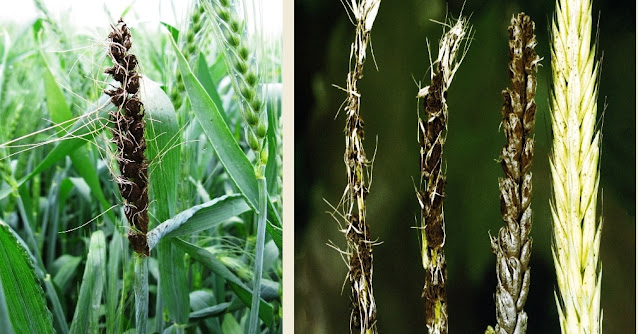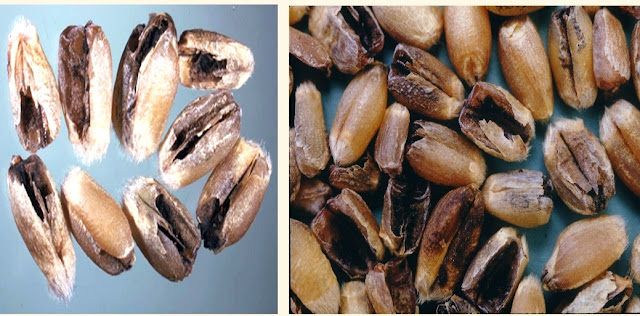Diseases of wheat :
There are various disease which affected the the wheat production such as:-
1. Stem Rust :
Caused by - Puccinia graminis tritici
Symptoms
∆ Reddish brown pustules observed on stem.
∆ The large number of uredospori burst, release their spores.
∆ Infected parts bursting to expose a mass of brown uredospores.
∆ Brownish appearance even from a distance.
Disease of wheat
Also Read 👇👇 click below
Disease of rice
Disease of sugarcane
Management
∆ plant certified or high quality, disease free seed.
∆ use rust resistant variety.
∆ single foliage spray of new systemic fungicide such as Bayleton, Diniconazol can control steam rust.
2. Leaf Rust :
Caused by : Puccinia recondita.
Symptoms .
∆ lesions are generally reddish brown in colour.
∆ Small circular to oval yellow spots on infected tissue of the upper leaf surface.
∆ As the disease progresses the sports developed into to orange coloured postulate that may be surrounded by a yellow halo.
∆ Black spores may be produced, resulting in a mixture of of orange and black lesion on the the leaf.
Management
∆ plant certified or high quality, disease free seed.
∆ use rust resistant variety.
∆ single foliage spray of new systemic fungicide such as Bayleton, Diniconazol can control steam rust.
3. Strip Rust ( yellow rust ) :
Caused by - Puccinia striiformis.
Symptoms
∆ stripe Rust include long strips of small yellow or orange blister like lesions called Pustules.
∆ The disease is most common on leaves but also can affected glums.
∆ Appears early in the spring.
Management
∆ plant certified or high quality, disease free seed.
∆ use rust resistant variety.
∆ single foliage spray of new systemic fungicide such as Bayleton, Diniconazol can control steam rust.
4. Loose smut of wheat :
Caused by - Ustilago tritici.
Symptoms
∆ it can only be seen at the time of flowering through the plant are infected right after seed germination.
∆ Ears of infected one emerge early than healthy one and transformed into black powdery mass.
∆ whole ears is covered by delicate silvery membrance.
∆ Resulting in formation of very dark olive brown powdery mass.
Management
∆ use systemic fungicide.
∆ Use resistant varieties.
∆ Remove the diseased plant or plant parts.
∆ Plant certified or high quality, disease free seed.
5. Kernel Bunt :
Caused by - Neovassia indica
Symptoms.
∆ Black masses of spores on section of the grain which crush easily into a black powder, and produce an odour like rotten fish.
∆ Some grain in the spike are partially or wholly converted into black powdery masses.
∆ The fungus is both seed borne and soil born.
∆ The black powdery seed is foul smell due to presence of trimethylamine.
Management.
∆ Grow resistant varieties.
∆ Use disease free seeds.
∆ Treat seed with Agrosen GN or Ceresan or Vitavax @ 2.25 g/kg.
∆ Avoid excess Irrigation at the time of flowering.
∆ Crop rotation can be done.
6. Powdery mildew :
Caused by - Erysiphe graminis var. Tritici
Symptoms
∆ Greyish white powdery growth appears on leaf , sheath , stem and floral part.
∆ Powdery growth later become black lesion.
∆ Drying of leave and other parts.
Management.
∆ Resistant varieties.
∆ Crop rotation.
∆ Avoid excessive use of nitrogen fertilizer.
∆ Spray fungicide.
7. Ear Cockle Disease of wheat :
Caused by - Anguina tritici.
Anguina tritici is a wheat seed gall nematodes.
Symptoms.
∆ The presence of anguina tritici is indicated by dring plants,wrinkled and twisted leaves of young plant, reduced and irregular heads (ear) having the typical cockles ( light to dark brown , round Gall instead of healthy grain.)
∆ The ears of diseased plant do not emerge property.
∆ Growth of the plant reduces.
Management
∆ crop rotation should be done.
∆ Hot water treatment should be give hand to the seed for 2 hours at 50 degree Celsius.
∆ Crop rotation with none host crop for 1 to 2 years will eliminate nematodes, present in the field.
THANK YOU.....
🥕🌹🌺🏵️🌼🌴....






